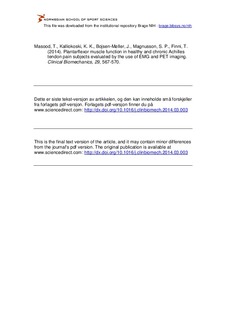| dc.contributor.author | Masood, Tahir | |
| dc.contributor.author | Kalliokoski, Kari K. | |
| dc.contributor.author | Bjosen-Møller, Jens | |
| dc.contributor.author | Magnusson, S. Peter | |
| dc.contributor.author | Finni, Taija | |
| dc.date.accessioned | 2015-05-27T10:13:46Z | |
| dc.date.available | 2015-05-27T10:13:46Z | |
| dc.date.issued | 2014-05 | |
| dc.identifier.citation | Clinical Biomechanics. 2014, 29, 567-570 | nb_NO |
| dc.identifier.uri | http://hdl.handle.net/11250/284086 | |
| dc.description | I Brage finner du siste tekst-versjon av artikkelen, og den kan inneholde ubetydelige forskjeller fra forlagets pdf-versjon. Forlagets pdf-versjon finner du på www.sciencedirect.com: http://dx.doi.org/10.1016/j.clinbiomech.2014.03.003 / In Brage you'll find the final text version of the article, and it may contain insignificant differences from the journal's pdf version. The original publication is available at www.sciencedirect.com: http://dx.doi.org/10.1016/j.clinbiomech.2014.03.003 | nb_NO |
| dc.description.abstract | Achilles tendon pathologies may alter the coordinative strategies of synergistic calf muscles. We hypothesized that both surface electromyography and positron emission tomography would reveal differences between symptomatic and asymptomatic legs in Achilles tendinopathy patients and between healthy controls.
Methods: Eleven subjects with unilateral chronic Achilles tendon pain (28 years) and eleven matched controls (28 years) were studied for triceps surae and flexor hallucis longus muscle activity in response to repetitive isometric plantarflexion tasks performed at 30% of maximal voluntary contraction using surface electromyography and glucose uptake using positron emission tomography. Additionally, Achilles tendon glucose uptake was quantified.
Findings: Normalized myoelectric activity of soleus was higher (P < 0.05) in the symptomatic leg versus the contralateral and control legs despite lower absolute force level maintained (P < 0.005). Electromyography amplitude of flexor hallucis longus was also greater on the symptomatic side compared to the healthy leg (P < 0.05). Both the symptomatic and asymptomatic legs tended to have higher glucose uptake compared to the control legs (overall effect size: 0.9 and 1.3, respectively). Achilles tendon glucose uptake was greater in both legs of the patient group (P < 0.05) compared to controls. Maximal plantarflexion force was ~ 14% greater in the healthier leg compared to the injured leg in the patient group.
Interpretations: While the electromyography showed greater relative amplitude in the symptomatic leg, the results based on muscle glucose uptake suggested relatively similar behavior of both legs in the patient group. Higher glucose uptake in the symptomatic Achilles tendon suggests a higher metabolic demand. | nb_NO |
| dc.language.iso | eng | nb_NO |
| dc.publisher | Elsevier | nb_NO |
| dc.subject | biomechanics | nb_NO |
| dc.subject | triceps surae | nb_NO |
| dc.subject | achilles tendon | nb_NO |
| dc.subject | glucose uptake | nb_NO |
| dc.subject | tendinopathy | nb_NO |
| dc.subject | [18F]-Fluorodeoxyglucose | nb_NO |
| dc.title | Plantarflexor muscle function in healthy and chronic Achilles tendon pain subjects evaluated by the use of EMG and PET imaging | nb_NO |
| dc.type | Journal article | nb_NO |
| dc.type | Peer reviewed | nb_NO |
| dc.subject.nsi | VDP::Mathematics and natural science: 400::Basic biosciences: 470 | nb_NO |
| dc.subject.nsi | VDP::Technology: 500::Medical technology: 620 | nb_NO |
| dc.subject.nsi | VDP::Medical disciplines: 700::Basic medical, dental and veterinary science disciplines: 710 | nb_NO |
| dc.subject.nsi | VDP::Medical disciplines: 700::Clinical medical disciplines: 750 | nb_NO |
| dc.source.journal | Clinical Biomechanics | nb_NO |
| dc.description.localcode | Seksjon for fysisk prestasjonsevne / Department of Physical Performance | nb_NO |
